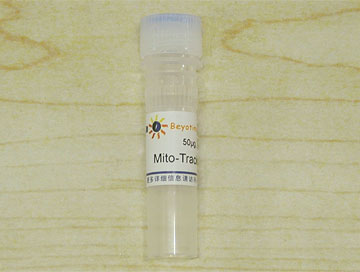|
||||||||||
产品简介
产品简介:
| 产品编号 | 产品名称 | 产品包装 | 产品价格 |
| C1046 | Lyso-Tracker Red(溶酶体红色荧光探针) | 50μl | 325.00元 |
Lyso-Tracker Red是一种溶酶体(lysosome)红色荧光探针,可以用于活细胞溶酶体特异性荧光染色。
Lyso-Tracker Red为采用Molecular Probes公司的DND 99进行了荧光标记的带有弱碱性的荧光探针,可以选择性地滞留在偏酸性的溶酶体中,从而实现对于溶酶体的特异性荧光标记。中性红(Neutral Red)和吖啶橙(Acridine Orange)也都可以对溶酶体进行荧光染色,但中性红和吖啶橙的染色缺乏特异性。
Lyso-Tracker Red呈红色荧光,检测时的最大激发波长为577nm,最大发射波长为590nm。
按照1:20000的比例稀释,可以配制1000ml Lyso-Tracker Red工作液。
包装清单:
产品编号 |
产品名称 |
包装 |
C1046 |
Lyso-Tracker Red(1mM) |
50μl |
- |
说明书 |
1份 |
保存条件:
-20℃避光保存,半年有效。
注意事项:
Lyso-Tracker Red(1mM)在4℃、冰浴等较低温度情况下会凝固而粘在离心管管底、管壁或管盖内,可以20-25℃水浴温育片刻至全部融解后使用。对于微量的液体,每次使用前先离心数秒钟,使液体充分沉降到管底。
荧光染料均存在淬灭问题,请尽量注意避光,以减缓荧光淬灭。
需自备盖玻片和载玻片(可以向碧云天订购)。
为了您的安全和健康,请穿实验服并戴一次性手套操作。
使用说明
使用说明:
1. Lyso-Tracker Red工作液的配制:
a. 取少量Lyso-Tracker Red按照1:13333-1:20000的比例加入到细胞培养液或适当的溶液(例如含钙镁离
子的HBSS)中,使最终浓度为50-75nM。例如取1μl Lyso-Tracker Red加入到20ml或13.33ml细胞培养
液或适当的溶液(例如含钙镁离子的HBSS)中。混匀后即为Lyso-Tracker Red工作液。HBSS with Ca2+
& Mg2+ (C0219)可以向碧云天订购。
b. Lyso-Tracker Red工作液使用前需37℃预温育。
注:工作液中Lyso-Tracker Red的浓度可以根据实际情况进行适当调整。为降低背景,在染色效果可
以接受的范围内,建议尽量使用较低浓度的Lyso-Tracker Red。
2. 溶酶体的荧光标记:
a. 去除细胞培养液,加入步骤1配制好的并37℃预温育的Lyso-Tracker Red染色工作液,与细胞37℃共
孵育30-120分钟。
b. 去除Lyso-Tracker Red染色工作液,加入新鲜的细胞培养液。
c. 随后通常用荧光显微镜或激光共聚焦显微镜进行观察。此时可观察到溶酶体呈明亮的强荧光染色。如
果染色效果欠佳,可以提高Lyso-Tracker Red染色工作液中Lyso-Tracker Red的浓度或在推荐的时间
范围内适当延长染色时间。
产品图片

相关产品
相关论文
使用本产品的相关论文:
1. Liu G, Ma S, Li S, Cheng R, Meng F, Liu H, Zhong Z.
The highly efficient delivery of exogenous proteins into cells mediated by biodegradable
chimaeric polymersomes.
Biomaterials. 2010;31(29):7575-85.
2. Huang X, Zhuang J, Teng X, Li L, Chen D, Yan X, Tang F.
The promotion of human malignant melanoma growth by mesoporous silica nanoparticles
through decreased reactive oxygen species.
Biomaterials. 2010;31(24):6142-53. Epub 2010 May 26.
3. Jialin G, Xuefan G, Huiwen Z
SID1 transmembrane family, member 2 (Sidt2): a novel lysosomal membrane protein.
Biochem Biophys Res Commun. 2010 Nov 26;402(4):588-94.
4. Wu Z, Tang M, Tian T, Wu J, Deng Y, Dong X, Tan Z, Weng X, Liu Z, Wang C, Zhou X.
A specific probe for two-photon fluorescence lysosomal imaging.
Talanta. 2011 Dec 15;87:216-21.
5. Gan Q, Dai D, Yuan Y, Qian J, Sha S, Shi J, Liu C
Effect of size on the cellular endocytosis and controlled release of mesoporous
silicananoparticles for intracellular delivery.
Biomed Microdevices. 2012 Apr;14(2):259-70.
6. Chen Y, Chen H, Zhang S, Chen F, Sun S, He Q, Ma M, Wang X, Wu H, Zhang L, Zhang L,
Shi J.
Structure-property relationships in manganese oxide--mesoporous silica nanoparticles
used for T1-weighted MRI and simultaneous anti-cancer drug delivery.
Biomaterials. 2012 Mar;33(7):2388-98.
7. Liu M, Li ZH, Xu FJ, Lai LH, Wang QQ, Tang GP, Yang WT
An oligopeptide ligand-mediated therapeutic gene nanocomplex for liver cancer-targeted
therapy.
Biomaterials. 2012 Mar;33(7):2240-50.
8. Wang J, Dong S.
ICAM-1 and IL-8 are expressed by DEHP and suppressed by curcumin through ERK and p38
MAPKin human umbilical vein endothelial cells.
Inflammation. 2012 Jun;35(3):859-70.
9. Hu Q, Wang J, Shen J, Liu M, Jin X, Tang G, Chu PK
Intracellular pathways and nuclear localization signal peptide-mediated gene
transfection bycationic polymeric nanovectors.
Biomaterials. 2012 Feb;33(4):1135-45.
10.Sun X, Chen J, Chen H, Liang W.
Polyethylenimine modified liposomes as potential carriers for antitumor drug delivery
in vitro.
Pharmazie. 2012 May;67(5):426-31.
11.Qi Gan , Xunyu Lu , Wenjie Dong , Yuan Yuan , Jiangchao Qian , Yongsheng Li , Jianlin
Shi and Changsheng Liu
Endosomal pH-activatable magnetic nanoparticle-capped mesoporous silica for
intracellular controlled release
J. Mater. Chem., 2012, Advance Article
12.Hao X, Wu J, Shan Y, Cai M, Shang X, Jiang J, Wang H.
Caveolae-mediated endocytosis of biocompatible gold nanoparticles in living Hela cells.
J Phys Condens Matter. 2012 Apr 25;24(16):164207.
13.Gao J, Xia L, Lu M, Zhang B, Chen Y, Xu R, Wang L.
TM7SF1 (GPR137B): a novel lysosome integral membrane protein.
Mol Biol Rep. 2012 Sep;39(9):8883-9. Epub 2012 Jun 24.
14.Zhang E, Luo S, Tan X, Shi C.
Mechanistic study of IR-780 dye as a potential tumor targeting and drug delivery agent.
Biomaterials. 2014 Jan;35(2):771-8. doi: 10.1016/j.biomaterials.2013.10.033. Epub 2013
Oct 20.
15.Du F, Min Y, Zeng F, Yu C, Wu S.
A targeted and FRET-based ratiometric fluorescent nanoprobe for imaging mitochondrial
hydrogen peroxide in living cells.
Small. 2014 Mar 12;10(5):964-72. doi: 10.1002/smll.201302036. Epub 2013 Sep 23.
16.He H, Xiao H, Kuang H, Xie Z, Chen X, Jing X, Huang Y.
Synthesis of mesoporous silica nanoparticle-oxaliplatin conjugates for improved
anticancer drug delivery.
Colloids Surf B Biointerfaces. 2014 May 1;117:75-81. doi: 10.1016/j.colsurfb.2014.
02.014. Epub 2014 Feb 19.
17.Jiang S, Gong X, Zhao X, Zu Y.
Preparation, characterization, and antitumor activities of folate-decorated docetaxel-
loaded human serum albumin nanoparticles.
Drug Deliv. 2014 Jan 29.
18.Han J, Wang Q, Zhang Z, Gong T, Sun X.
Cationic bovine serum albumin based self-assembled nanoparticles as siRNA delivery
vector for treating lung metastatic cancer.
Small. 2014 Feb 12;10(3):524-35. doi: 10.1002/smll.201301992. Epub 2013 Sep 19.
苏ICP备06009238号 |
